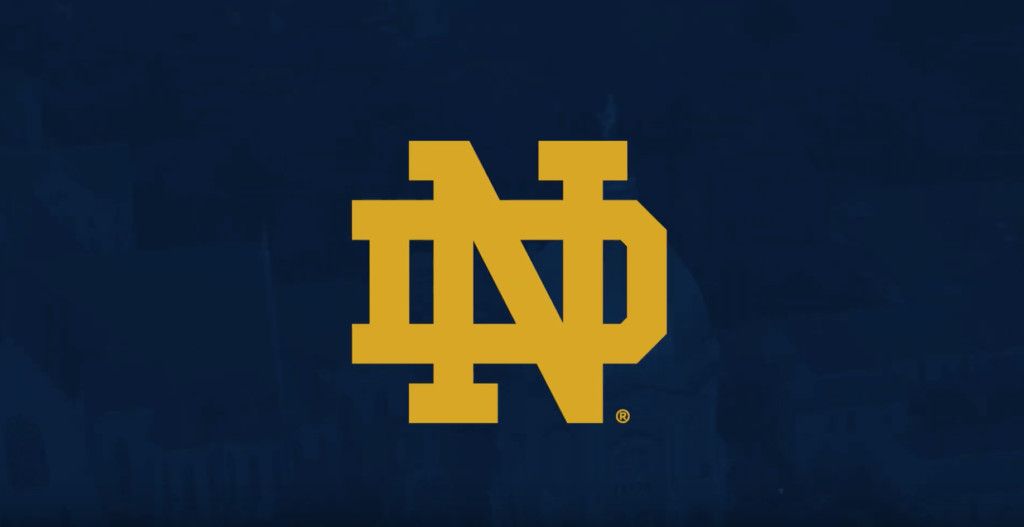Complete Release in PDF Format![]()
![]() Download Free Acrobat Reader
Download Free Acrobat Reader
Feb. 20, 2002
Prior to the Notre Dame baseball program’s 1998 fall season, head coach Paul Mainieri made a one-time decision that he has yet to repeat in his eight years at the helm of the Irish program.
Mainieri decided to play a game at Michigan State during that upcoming fall season – even though he knew it would count against the 56 games his team would be permitted to play the following spring. The reason behind his decision was simple: the 1998 Irish team had lost several veterans to graduation and the professional draft, many of them from key positions, and several members of the large incoming class likely would be facing the challenge of starting as freshmen in the ’99 season.
The newcomers included darting centerfielder Steve Stanley, hard-nosed catcher Paul O’Toole and a third baseman, Andrew Bushey, who had a game’s-worth of dirt across his uniform by the start of the third inning. Several other freshmen played key roles that day and went on to be important contributors during the next three seasons as the Notre Dame program took its place among the nation’s elite.
Three years later, most of those freshmen remain and they are part of an eight-member senior class that already has combined for 744 career starts on the college level.
The fall of 2001 likewise held major significance for another Notre Dame freshman class, as the current group of 13 newcomers was ranked by Baseball America as the nation’s top recruiting class. And thus the convergence of those two groups forms the basis for high expectations as the Irish head into their 2002 opener ranked as high as third in the nation (the highest preseason ranking in the program’s history).
“It would be very fulfilling for this senior class to go out with another great season – and that includes contending for a spot in the College World Series,” says Mainieri., whose squad is set to return 16 of 21 letterwinners but must replace one of the nation’s top pitching duos, All-American Aaron Heilman and first team all-BIG EAST performer Danny Tamayo, while the only position starter lost is shortstop Alec Porzel (a four-year starter at three different positions who owns many of the Notre Dame and BIG EAST career records).
“This senior class epitomizes what Notre Dame baseball is all about and they have shown that special leadership from day one. Of course, now they are experienced and battle-tested – and they appreciate the important things like what it takes to get ready for a college season.
“They will be ready for the task at hand and the younger kids will feed off that … and they’ll learn from it as well.
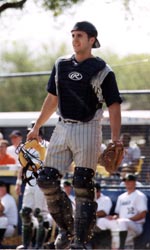 |
| Andrew Bushey |
Stanley, O’Toole and Bushey each are heading into their fourth season as starters, with the other returning regulars including junior outfielders Brian Stavisky and Kris Billmaier and the rightside infield tandem of sophomore second baseman Steve Sollmann and his classmate Joe Thaman at first base – with seniors Matt Bok and Ken Meyer again slated to split the DH duties.
Three of the returners – team captains Bushey and Stanley, along with Sollmann – were first team all-BIG EAST performers a year ago, with Stanley earning BIG EAST co-player of the year and All-America honors. Stavisky and O’Toole were named second team all-BIG EAST in 2001 while Bok was a third-team selection, as was pitcher J.P. Gagne – who combines with fellow junior righthander Peter Ogilvie as Notre Dame’s top returning pitchers from the 2001 staff that finished fifth in the nation with a 3.22 team ERA.
The Irish offense returns its top five leaders in batting average from 2001 while seven of the eight starting position players – plus the senior DH tandem of Bok and Meyer – likewise return. The offense returns 85% of its hits, 82% of the RBI and 81% of the home runs (33 of 41) from the 2001 squad that finished 26th in the nation with a .322 team batting average (the returners also accounted for 91% of the stolen bases, 84 of 92, and 86% of the walks in 2001). http://publish.netitor.com/photos/schools/nd/sports/m-basebl/01-02action/a-ogilvie-021902.jpg
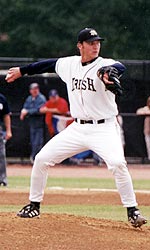 |
| Peter Ogilvie |
The loss of Heilman and Tamayo leaves a returning group of pitchers that started less than half of the 2001 games (30 of 63) and registered just 26 of the 49 wins (also 47%). The eight returning pitchers accounted for 49% of the innings, 43% of the strikeouts and all eight saves from a year ago.
Despite the high number of returning position starters, the Irish are slated to make two shifts to their defensive alignment, as Stavisky will flip spots with Billmaier (who will shift from left to right) while Bushey and O’Toole likely will split time behind the plate and at third.
“We expect those changes to benefit us in a number of ways,” says Mainieri, whose 2001 team extended the program’s string of seasons with 40-plus wins to 13.
“Brian should be more comfortable in left field and will be able to focus more on his hitting while Kris is such a great athlete that he should make a quick transition to playing in right, much as he did as a freshman when we moved him from the infield.
“People also will be surprised to see Bushey behind the plate and O’Toole at third. We should be very strong defensively with either option in place and Paul won’t have to catch nearly the number of innings that he did in the previous seasons.”
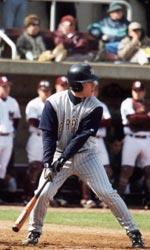 |
| Kris Billmaier |
Six of the top nine returning batters – all but Sollmann, Billmaier and Meyer – bat from the left side, with the likely starting lineup to feature Stanley at leadoff and Sollmann in the No. 2 hole. Highly-touted freshman shortstop Matt Macri appears up to the challenge of batting in the pressure-packed No. 3 spot while Stavisky is the likely cleanup hitter, followed by O’Toole or Billmaier (depending on the opposing pitcher) and Bushey at the No. 7 spot.
With a young group of pitchers set to begin their college careers, the Irish will look to the offense to set the tone during the early weeks of 2002. Four of the freshman hurlers are likely to play big roles, with that group led by prep All-American Chris Niesel and New Jersey pitcher of the year Martin Vergara, plus national-team members Grant Johnson (U.S.) and John Axford (Canada).
Here’s a closer look at the Irish, by position:
Bushey (Boardman, Ohio) – who elected to have surgery on his non-throwing shoulder in the summer of 2001 – has continued to show great promise as a catching prospect, after three stellar defensive seasons as the everyday third baseman. He also will be a force while batting in the 7-hole, with the lefthander quietly finishing second among all BIG EAST players last season for conference batting average (.402) and RBI (27).
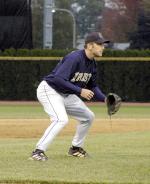 |
| Paul O’Toole |
“Bushey has shown exceptional quickness behind the plate, both with his feet and hands, and he has great arm strength to match with that quickness,” says Mainieri of Bushey, whose overall 2001 totals included a .335 batting average, 36 RBI and 17 doubles.
“He always has been a great leader for this program and you had the sense that his offense was going to come around like it did last year. We always knew that he would be a great gap-to-gap hitter but I think he will be even better this year.”
The fiery O’Toole (Lakewood, Ohio), a semi-finalist for the 2001 Johnny Bench Award, should benefit from fewer innings behind the plate and will be looking for a quicker start to the 2002 season, after surging in each of the previous campaigns (10 of his 20 career home runs have come in May).
O’Toole’s productive 2001 fall season included working on his defense at third base, where he showed excellent hands, range and reactions to go along his strong arm (he threw out 24 of 59 basestealers in 2001) and gritty all-around play (he hit .323 as a junior, with 35 RBI, four home runs and 15 stolen bases).
“O’Toole probably had the best fall of anyone on the team. He was markedly improved, healthy and trim, and explosive in his actions, with great bat speed, arm strength and quickness on the bases,” says Mainieri.
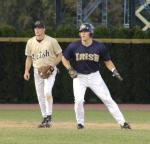 |
| Matt Macri (left) and Steve Sollmann |
Yet another Ohio native returns for the Irish at second base, with Sollmann (Cincinnati, Ohio) heading into his second season after earning BIG EAST rookie of the year and Freshman All-America honors in 2001 (thanks to a .362 batting average, 36 RBI, five home runs and 23 stolen bases). Formerly a centerfielder during his prep days, the athletically-gifted Sollmann performed admirably during his freshman-year position switch while carrying a batting average above .400 into midseason.
“Steve Sollmann simply is one of the best young players in the country and he’s a true winner who is able to back up the tremendous confidence that he plays with,” says Mainieri of Sollmann, who joined Stanley and Stavisky in receiving preseason All-America accolades for 2002.
“With a year of playing second base under his belt, plus a summer in the Cape Cod League, Steve has made great strides in his defense to make him even a better all-around player. When you combine that with clutch hitting, smart baserunning and some timely power, you’re talking about a pretty special player.”
Thaman (St. Louis, Mo.) – a classic gap and down-the-line hitter who totaled more doubles (15) than singles (11) in 2001 – rapidly is establishing himself as one of the nation’s best defensive first basemen, a tradition at Notre Dame set by his predecessors Dan Leatherman and Jeff Felker. The lefthander has added weight and strength to his 6-4, 210-pound frame and could improve on his 2001 stats (.284, 25 RBI, 2 HR) as he looks to shift his game into another gear.
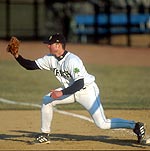 |
| Joe Thaman |
Macri (Dowling, Iowa) has filled Porzel’s vacant shortstop position after an amazing high school career that saw him named Iowa’s player of the year in football and baseball, after leading Dowling High School to the state championship in both sports (he hit .465 with 10 home runs and 65 RBI during the 2001 season, which is played during the summer). Macri joined Niesel and Johnson by falling in the Major League draft, due to his strong commitment to attend Notre Dame, with the Minnesota Twins selecting him in the 17th round before Macri made his final decision to join the Irish baseball program.
Baseball America already has taken a peek ahead to 2003 and has forecasted Macri as the No. 4 prospect for that draft (he will be draft-eligible in 2003, by turning 21 prior to the draft). The magazine also has Macri currently slotted as the No. 2 freshman prospect in all of college baseball, behind Vanderbilt lefthander Jeremy Sowers.
“This is not your typical freshman that we are talking about. He was on a big stage throughout his high school career and has excelled under tremendous pressure and in key situations,” says Mainieri of Macri, who made a big splash at Notre Dame’s intrasquad Blue-Gold series, batting 5-for-11 with a linedrive home run and a pair of triples.
“Matt just does so many things on a high level – his bat speed and ability to drive the ball, plus his speed on the bases, range in the field and great arm strength – and I can’t think of a better freshman in the country. He also loves to compete and is the type of player who always seems to find a way to beat you. That’s a tough combination for any team to face.”
Mainieri has similar high praise for Stanley (Upper Arlington, Ohio), calling the speedy senior “the best centerfielder in the nation and probably one of the best all-around players in college baseball.” Stanley’s All-America 2001 season included a .400 batting average, 31 stolen bases and 76 runs scored from his leadoff position and he heads into his final season with a .363 career batting average to go along with an amazing streak of having started all 188 games of his career in center field for the Irish (he missed just 14 total innings during his first three seasons).
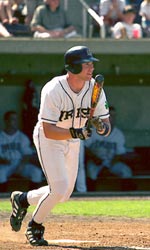 |
| Brian Stavisky |
“It’s hard to believe that a player of Steve’s stature (5-8, 155) can have such an impact on the game,” says Mainieri. “But when you combine what he does offensively with all the ground he covers in the outfield and the havoc he wrecks on the bases, you have a player that is impacting the game in every way possible … I’m just glad he’s on our team.”
Stavisky (Port Allegany, Pa.) is a player who strikes the more traditional fear into opponents, due to his imposing 6-3, 220-pound frame and lightning-quick wrists that can combine with his powerful swing to send tape-measure blasts over the fences.
“This really could be a breakout year for Brian and that’s saying a lot, because he’s already had two pretty strong seasons to his credit,” says Mainieri of the player who is rated by Baseball America as the college game’s No. 25 prospect for 2002.
“Brian will have great hitters all around him and could go out and show what he is capable of – nobody has a quicker or more powerful swing than he does … and when he adds consistency to that, watch out.”
Stavisky’s 2001 season (.386, 10 HR, 66 RBI) included benchmark moments at both ends – as he opened the season by batting 9-for-13 (with 10 consecutive times on base) before closing with four home runs and 25 total bases in the NCAA regional.
Billmaier (Woodinville, Wash.) is expected to boost his .257 batting average from a year ago (after hitting .354 as a freshman) and again is a leading candidate to hit in the No. 5 spot. A look inside the numbers shows that Billmaier hit 65 points higher (.322) with runners in scoring position and was nearly automatic with a runner on third base and fewer than two outs, bringing home the run in 19 of those 22 opportunities last season. He also finished fifth on the team in on-base percentage (.392), thanks to 30 walks and nine times hit-by-pitch, and struck out only 15 times (just twice on called third-strikes).
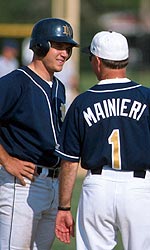 |
| Matt Bok |
“Kris Billmaier is my type of player, because he never backs down and seemingly always rises to the occasion when you need him,” says Mainieri. “He certainly is capable of hitting for better average but you’d be hard-pressed to find a player who had more big hits than Kris did for us last season.”
Bok and Meyer’s return for their final season gives the Irish an experienced DH from both sides of the plate. The pair had comparable seasons in 2001, with Bok’s .333 average in conference games helping him earn third team all-BIG EAST honors (he made 30 starts and hit .286 overall with 17 RBI and one home run while Meyer’s .271-20-3 stat line was virtually the same, in 24 starts).
The switch-hitting Bok (Akron, Ohio) – who hit mostly lefthanded in 2001, while his 2000 highlights included RBI from both sides in an NCAA tournament win over Tulane – is coming off a strong fall season and again could prove to be a clutch extra-base threat, after seeing his slugging percentage jump from .306 in 2000 to .459 last season. “Matt was very consistent in the fall and showed some great bat speed,” says Mainieri. “He’s playing very hard-nosed right now and should be due for another strong year.”
Meyer (Fort Myers, Fla.) endured a junior season that was hampered by pain in his shoulders, with summer surgery clearing the way for the veteran slugger who hit .326 and racked up 77 total bases (.558 slugging pct.) as a sophomore in 2000. Meyer’s penchant for clutch hits helped gain him a place in Notre Dame baseball history during the 2001 season versus Central Michigan, as three of his teammates reached base in the bottom of the ninth with two outs and two-strike counts before Meyer launched an 0-2 pitch over the leftfield fence – ending the game (6-4) and vaulting the Irish on to the program’s first No. 1 ranking days later.
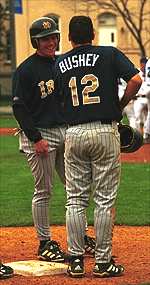 |
| Ken Meyer |
“Kenny Meyer is such a terrific competitor and always has been all about helping make this program the best it can be. He’s had some big series for us in BIG EAST play and is just such an important part of the lineup as one of those key righthanded bats,” says Mainieri. “Now that he’s healthy, it looks like Ken could be on pace for the best season of his career.”
Senior Matt Strickroth (Santa Margarita, Calif.) likely will serve as the team’s fourth outfielder and also could see time at DH or even first base. A dedicated teammate who had a strong fall season, the 6-4, 230-pound Strickroth started 64 of the 110 games he played the past three seasons while delivering an assortment of big hits – including two towering home runs last season at the University of the Pacific, in his home state.
Sophomore Javier Sanchez (Miami, Fla.) and freshman Geoff Milsom (New York, N.Y.) give the Irish a pair of capable utility players, with both turning in pleasantly surprising fall seasons. The 6-2, 200-pound Sanchez has begun learning the finer parts of first-base play – with his classmate Thaman serving as a classic case study – while ranking as one of the team’s top backup options at the other infield positions (he played just a handful of innings in 2001, before a strong summer season with the Delaware Cows in the Great Lakes League).
Milsom could emerge as the team’s top reserve at the middle infield positions. A poised and hard-nosed competitor, Milsom’s play often has appeared to the Irish coaches as the second coming of Andrew Bushey – complete with the strong throwing arm and a quality lefthanded swing.
Junior Mike Holba (Lansing, Ill.) will be looking for his opportunities in 2002 as a backup first baseman and DH. The 6-8, 240-pound righthander has displayed some clutch hitting and booming home runs during the past two fall seasons and could be an added part of the Irish offense in 2002.
Freshman infielder/outfielder Matt Edwards was limited during fall practice due to a knee injury but has shown the ability to develop into an excellent hitter on the college level (he hit .460 with eight home runs, 20 RBI and 36 walks as a senior at Lee-Davis High School).
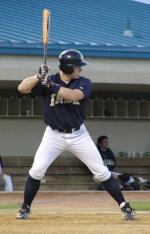 |
| Brent Weiss |
Yet another freshman, Brent Weiss (Cockeysville, Md.), will serve as the team’s third catcher while getting a look at DH and as a reserve outfielder. The 6-1, 215-pound righthander launched a home run in last fall’s Blue-Gold Series and has shown the ability to swing the bat with authority and power to all fields (he hit .450 as a senior at St. Paul’s High School, setting school records with eight home runs in a season and 24 in his career).
Weiss’s classmate Jay Molina (Moline, Ill.) is slated to miss the 2002 season, after undergoing ACL surgery on his right elbow in June of 2001. The scrappy newcomer still has managed to impress the Notre Dame coaches in catching drills, with great quickness behind the plate to complement his strong leadership and ability to swing the bat upon his return (he likely will fill a key role in 2003, with the impending graduation of O’Toole and Bushey).
Others who round out the Irish position players includes sophomore infielder/DH Zach Sisko (Belleville, Mo.) and the freshman duo of outfielder George Howard (Pine Bluff, Ark.) and catcher Mike Milligan (Oklahoma City, Okla.), who both earned roster spots following walk-on tryouts last fall. Sisko has made strides with his lefthanded swing and put together a solid summer in the wooden-bat Central Illinois League before registering some big hits in last fall’s Blue-Gold series.
The pitching forecasts start with Ogilvie (Buffalo Grove, Ill.), who won five of his six decisions in 2001 and will be Notre Dame’s strongest candidate for the No. 1 starter role. The 6-3, 215-pound righthander showed in 2001 that he is more than capable of delivering prime-time performances, with complete-game victories over Michigan and Florida International (in the NCAAs). Boasting a “sneaky fastball” (in the words of his head coach) and a curve with good break, Ogilvie’s clever approach to pitching and steady personality help to make him a natural fit for a clutch weekend starter role.
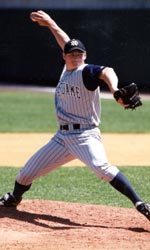 |
| J.P. Gagne |
“Pete was a kid who basically had not pitched much during the previous three years but he came out last year and proved that he can deliver in big games,” says Mainieri of Ogilvie, whose 1.90 season ERA narrowly trailed Heilman’s 1.74 and would have ranked ninth in the nation (his 52 innings fell 11 shy of the NCAA minimum). His eight-game totals included 30 strikeouts, just 11 walks and 44 hits allowed in the 52 innings.
Gagne (Bloomington, Minn.) also will be relied on for providing veteran stability, with his 143 career innings ranking as the most on the staff by a comfortable margin (senior Drew Duff is next, with 130). A fearless competitor who won the first five decisions of his freshman season, Gagne’s early experiences on the college level already have included four starts in the NCAAs and two more at the BIG EAST Tournament (he has mixed 26 starts with 10 relief stints, often in long relief).
“J.P. is such a versatile pitcher and that could be very valuable this season, because there are a lot more unknowns regarding this staff,” says Mainieri of his most experienced pitcher, who added an impressive 2001 summer by going 11-1 with a 1.70 ERA, 65 Ks and 15 walks in 80 innings with the Hays (Kan.) Larks that played in the title game of the National Baseball Congress World Series.
Gagne – whose combined stats from his first two seasons include a 12-6 record, 4.90 ERA and 91 Ks in 144 innings (5-5, 5.35 in ’01) – delivered one of the most important starts of the banner 2001 campaign, when he flipped with Tamayo and won the second game at Rutgers, 8-2 (6 IP, 5 H, 2 R, 2 BB, 4 Ks). “That game showed what J.P. is all about and he will be a key factor in determining the depth of our 2002 staff,” adds Mainieri.
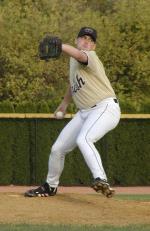 |
| Chris Niesel |
Niesel (Plantation, Fla.) – one of five pitchers named by Baseball America as a 2001 first team high school All-American (with the other four going pro) – is the most polished of the freshman pitchers, with good command of the strike zone on all three of his pitches and a fastball that has pushed into the low 90s.
A focused competitor who has been known for getting strikeouts in tense late-game situations, Niesel’s stellar senior season at Aquinas High School yielded a 13-0 record and 0.35 ERA, plus 120 Ks and just 11 walks in 81 innings. He made steady progress in fall practice, capped by a strong five-inning outing to open the Blue-Gold Series (1 R, 3 H, 5 Ks).
Axford (Port Dover, Ontario) turned down an offer from the Seattle Mariners, who had drafted him in the seventh round, instead opting to join the Notre Dame program as one of its best young pitchers. Canada’s top prep prospect also won his Blue-Gold Series start, allowing two runs on five hits and one walk while striking out five in his 70-pitch, five-inning stint. His combined stats last season with his Port Dover club team, Team Ontario and Team Canada included a 9-2 record and 1.47 ERA in 61.2 innings, with 97 Ks and 31 walks.
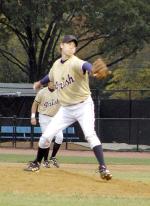 |
| John Axford |
“Niesel clearly is ready for the challenge of Division I baseball, after excelling in a high-caliber area like Broward County, but Axford is more polished than we had thought,” says Mainieri. “He’s got a great pitchers body (6-5, 175) and is going to throw harder as he gets stronger. He also is showing a great curve, so we look for him to be in the mix pretty early in the season.”
Vergara – a native of Paterson, N.J., and a 15th-round draft pick of the Cleveland Indians – is probably the best athlete among the freshman pitchers, with great quickness off the mound to complement a darting fastball that has touched 90 mph and a fluid delivery with no wasted movement. “Martin is a poised young man with a lot of pride, and consistency will be the key thing for him. If he maintains that steadiness, he’ll have a great freshman season,” says Mainieri of Vergara, whose senior season at DePaul Catholic High School included a 10-0 record, 0.30 ERA, 127 Ks and just 17 walks in 67 innings.
Johnson (Burr Ridge, Ill.) heads into his freshman season with several similarities to Heilman’s rookie year, when the future All-American posted a 33-inning shutout streak as the Irish closer en route to leading the nation with a 1.61 ERA. The 6-6, 220-pound fireballer can throw consistently in the low 90s and backs up his devastating deliveries with a fiery competitiveness (his final season at Lyons Township featured a 12-1 record and 0.70 ERA in 91 innings, with 120 Ks and 17 BB).
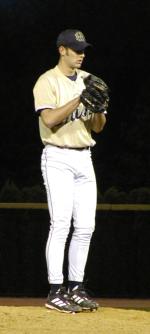 |
| Grant Johnson |
“It’ll be interesting to see how we end up using Grant, because he has the makings of being dominant as a starter or as a closer … but it’s a nice dilemma to have,” says Mainieri.
The above four freshmen posted similarly dominating stats as high school seniors in 2001, with their combined numbers including a 44-3 record, an 0.90 ERA (adjusted for nine innings), 464 Ks and just 76 walks in 291 combined innings (yielding combined nine-inning averages of 14.4 Ks, 2.3 walks and a 6.1 K-to-walk ratio).
Senior Matt Buchmeier (Greenwood, Ind.) also gained valuable experience in 2001, when he made five of his 13 appearances as the No. 3 starter before settling into a top middle-relief role. The veteran righthander likely will fill a similar role of middle reliever/midweek starter in 2002, after saving two games and posting a solid 3.91 ERA in his junior season (when he also split a pair of decisions).
After emerging as Notre Dame’s closer in 2001, junior Matt Laird (Bellaire, Texas) could best be utilized as a closer or middle reliever – with the versatility and fearlessness to log several strong innings or get the timely out with the game on the line. The proven winner won 10 of 13 decisions during his first two seasons, with a 3.53 ERA, 62 strikeouts and just 30 walks in 79 innings. His 2001 season included a 5-1 record and four saves – with his outings at Mississippi State (a save and win) and Rutgers (11-inning, series-sweeping win) providing some of the top moments in that historic season.
Several other pitchers could make valuable contributions in 2002, including senior Drew Duff (Sevierville, Tenn.), junior Brandon Viloria (Wailuku, Hawaii) and freshman Tyler Jones (Arlington, Texas). Duff has logged some strong outings while making 11 starts and 38 relief appearances, with a 10-4 record and 93 Ks in 113 innings. Viloria filled a classic setup role during the previous two seasons, when he won three of four decisions, saved two games and posted a 3.26 ERA in 23 appearances (all but one in relief). One of the team’s top fielding pitchers, the 5-11, 210-pound righthander delivered some key outings in 2001 and walked just six batters during his first two seasons (in 39 innings).
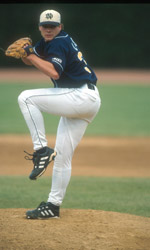 |
| Matt Laird |
Jones is a surging talent from a talent-rich baseball area. The 6-4, 205-pound righthander was a 30th-round draft choice of the Atlanta Braves and could provide great depth to the Irish staff due to his competitiveness and improving pitching technique.
Several pitchers round out what could prove to be the deepest staff in the eight-year Mainieri era, including junior Ryan Kalita (Oak Park, Ill.), sophomore Mike Morgalis (Cincinnati, Ohio) and a pair of lefthanded options in sophomore Cody Wilkins (Hudson, N.C.) and Scott Bickford (Owings, Md.).
Kalita made a pair of solid starts in 2001 and could contend for more midweek action, after a strong summer season with the Waynesboro (Va.) Generals (1.47 ERA) and a steady outing as a Game 3 starter in the annual Blue-Gold series last fall (5 IP, 2 R, 5 H, 3 BB, 3 Ks). The 6-4, 160-pound Bickford also could become a factor as he boosts his strength and finetunes his technique for the college game.







